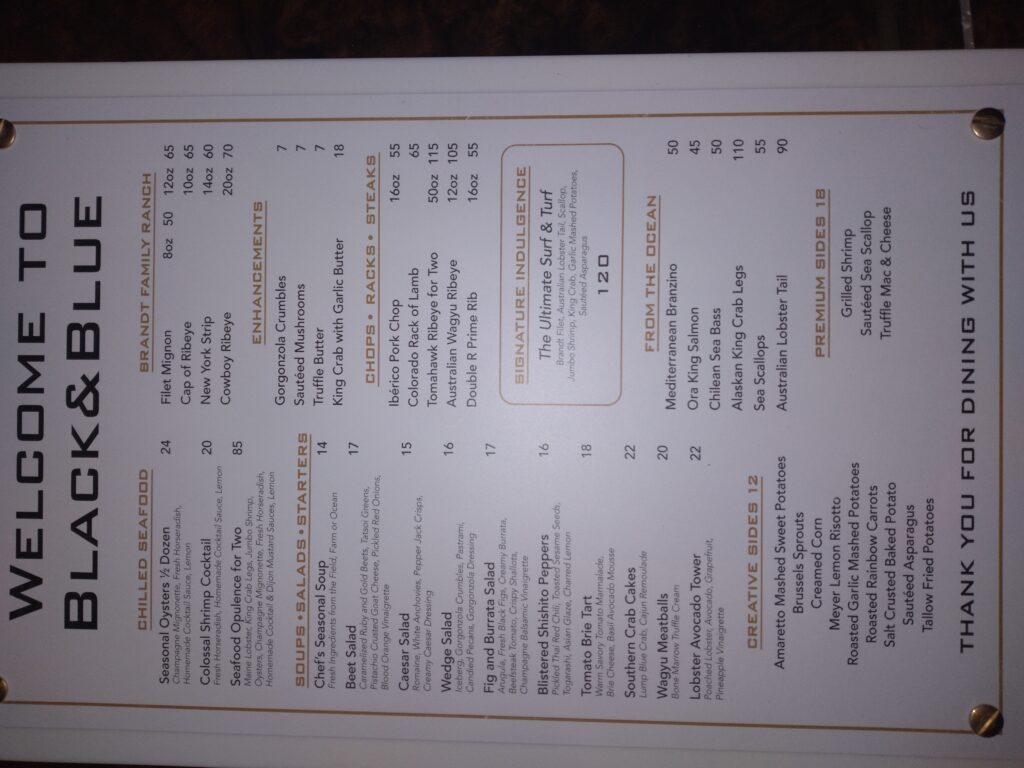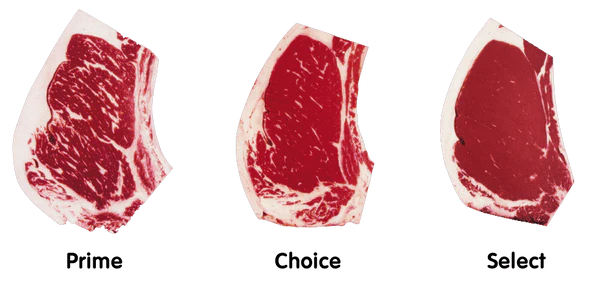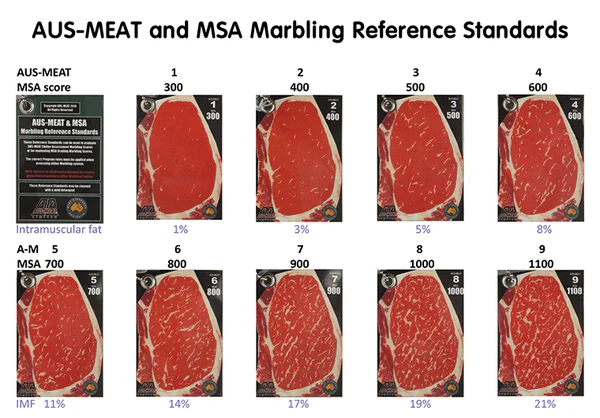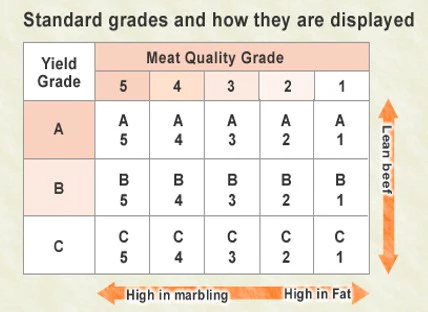It used to be if you wanted to eat the best quality steak in a well known 5 Star Gourmet Restaurant- you would order the USDA Prime Steak, but now there are even higher grading levels than that, so that you can have an even higher level of eating pleasure! On the farm the cattle are giving the ultimate “VIP” treatment their whole lives, they are free range, fed the best quality food, and are given massages- so that they produce the highest quality of beef- to give you the highest rated quality of steaks, and the ultimate dining experience!
The finest award winning restaurants around the world now serve the highest quality of beef – using a special rating system from approved rating charts. The three predominant grading systems are the US, the Japanese and the Australian. So as you can see from the below very useful beef grading chart- how these systems compare to each other: The highest rating level is the “A5” with the USA best quality of beef- top level is “USDA Prime steak 5+” which only reaches up to level “A4”, while the Australian highest level is 1100+ going all the way up to a grading level of 9, which reaches as far up on the conversion chart to the midway point of the highest rating level of “A5” ! However in Japan they have an even higher rating level going all the way up to a 12, which is the highest possible grading level of the “A5” category! So now you know what to look for when you are going to the finest gourmet restaurants in the world, to experience the best possible and available gourmet steaks on the entire planet!
The highest rating level is the “A5” with the USA best quality of beef- top level is “USDA Prime steak 5+” which only reaches up to level “A4”, while the Australian highest level is 1100+ going all the way up to a grading level of 9, which reaches as far up on the conversion chart to the midway point of the highest rating level of “A5” ! However in Japan they have an even higher rating level going all the way up to a 12, which is the highest possible grading level of the “A5” category! So now you know what to look for when you are going to the finest gourmet restaurants in the world, to experience the best possible and available gourmet steaks on the entire planet!
So in San Diego, California at the Valley View Casino & Hotel is the award winning Black & Blue Restaurant– where they now have available on their menu for you to experience the incredible gourmet Australian Wagyu Ribeye Beef Steak, with the highest Australian grading level of 1100+, which goes up to a rating level of a 9, which converts to about the midway point of the highest possible grading level of “A5”, with only Japan going a few notches higher up to a 12 of the “A5” rating category!
The Black & Blue has a great menu- with a very high quality and gigantic Tomahawk Ribeye steak that is over 3 pounds!! Their menu is below:  I had an incredible experience while I was eating this 10 ounce “A5” rated Australian Wagyu Ribeye Steak at the Black & Blue. On the very 1st bite I could taste the difference of the superior higher quality of the rich flavor of Wayyu meat, and almost like a sweetness flavor of this steak, as you can only imagine in the photo below:
I had an incredible experience while I was eating this 10 ounce “A5” rated Australian Wagyu Ribeye Steak at the Black & Blue. On the very 1st bite I could taste the difference of the superior higher quality of the rich flavor of Wayyu meat, and almost like a sweetness flavor of this steak, as you can only imagine in the photo below: 
In Las Vegas at the Paris Casino they have the Gordon Ramsay Steakhouse, where they do have available on their menu the Japanese Wagyu Beef Steak with the highest rating of “A5” from Japan, however they price it very expensively, and sell it starting at only 3 ounces of a very small steak- so that people can afford it. So when I did the math: to have a big size steak of this quality- it would cost about $1300! So it’s up to you where you want to go, and what country’s top gourmet steak you like to try, to maybe have that “A5” experience, that you will always be comparing to other steaks that you have in your travels!
After having this amazing gourmet steak experience, I had another great experience for dessert: a delicious German Chocolate Cake, that is the biggest slice you ever saw! I can always eat a lot of food, but this cake is so big, rich and filling that I could not finish it! The below photos do not do it justice- it is even bigger than it seems in the photos! Everyone of my friends that has had this giant sized cake- could not finish it either, so the Restaurant packs it in a box for you to take it home:
Everyone of my friends that has had this giant sized cake- could not finish it either, so the Restaurant packs it in a box for you to take it home: 
This has been voted the best Gourmet Restaurant for Steak & Seafood in San Diego, and has amazing service, with the finest food !! Hope to see you all at Black & Blue very soon!
We stayed just down the street, and only 5 minutes away at the only 4 Star & 4 Diamond Hotel in California: Harrah’s Resort & Casino SoCal:  and the view from our room at the new Dive Inn section of this hotel was like looking out at Paradise:
and the view from our room at the new Dive Inn section of this hotel was like looking out at Paradise:  Most consumers don’t have a clue about the origins of their beef and fall victim to some very misleading marketing out there, especially when it comes to Wagyu beef grading. Unfortunately, they waste money on sub-par products and miss out on the culinary experience of eating amazing tasting beef that they were hoping for, but after reading and understanding this guide on beef grading, you will know more about beef than 90% of the people out there.
Most consumers don’t have a clue about the origins of their beef and fall victim to some very misleading marketing out there, especially when it comes to Wagyu beef grading. Unfortunately, they waste money on sub-par products and miss out on the culinary experience of eating amazing tasting beef that they were hoping for, but after reading and understanding this guide on beef grading, you will know more about beef than 90% of the people out there.
The degree of marbling on the Rib-eye is the primary determinator of beef quality grade, and not all wagyu is the same.
Each country grades their beef differently. In the US, we follow the USDA grading (USDA Prime, USDA Choice) while others use letters and numbers like “A4”. Restaurants, supermarkets and butcher shops tend to mix-and-match these grades in their menus which can be very confusing.
BMS stands for Beef Marbling Score and it is the easiest way to compare across the different major grading standards. The first thing you will notice is that the Japanese grades go above and beyond the US grades. That is because of Wagyu beef. Wagyu beef is generally regarded as the highest grade due to its extreme levels of marbling.
Angus beef, which is the most predominant beef in America, averages a BMS of 2 but reaches a maximum BMS of 5. Grass-fed beef will grade Choice at best (very little of it may grade Prime but our grass-fed beef does).
Wagyu cattle averages BMS 4-6 but depending on genetics, nutrition, and age at time of slaughter, can go all the way up to BMS 11-12!
From a price-value perspective, the American Wagyu-Angus cross offers a very interesting price point. Japanese F1 Wagyu which is the perfect blend between the best of western and eastern beef standards.
The American Beef Grading System
The United States Department of Agriculture (or USDA), separates beef into eight different grades. The top five are sold to the consumer as cuts of beef, while the three lowest grades are typically only used for processed meats and canned meats. Quality beef is usually graded USDA CHOICE and USDA PRIME. The American system focuses on quality grades for tenderness, juiciness and flavor; and yield grades for the amount of usable lean meat on the carcass.
Recently, USDA collaborated with the United States Meat Export Federation and Colorado State University to develop an educational video about the beef grading process. This video provides a comprehensive overview of the beef grading system – from farm to table.
Restaurants generally only sell the three highest grades. High-end steakhouses only serve USDA Prime and/or Choice.
Above PRIME, the USDA is kind of arbitrary. A USDA Prime steak will present ‘Abundant’ marbling. There are no official grades above ‘Abundant’ in the USDA specifications. The terms ‘Very Abundant’ and ‘Extremely Abundant’ are arbitrary.  CONSUMER BEWARE: The USDA grading system primarily focuses on factors like marbling, color, and maturity of the beef. While these are important, this focus neglects other factors that can also significantly impact meat quality such as the diet of the cattle, their living conditions, and the handling of the meat post-slaughter.
CONSUMER BEWARE: The USDA grading system primarily focuses on factors like marbling, color, and maturity of the beef. While these are important, this focus neglects other factors that can also significantly impact meat quality such as the diet of the cattle, their living conditions, and the handling of the meat post-slaughter.
This means out of the three major grading systems the USDA is the one that leaves the most room for misinformation and many producers and retailers take advantage of it. This is why you will find a wide range in prices in USDA Choice and USDA Prime beef. The difference in quality even between two steaks with the same grade can be incredible.
The Australian Beef Grading System
The Australian beef grading system is known as Meat Standards Australia (or MSA) and is regulated by Meat and Livestock Australia (MLA).
The MSA is a relatively new grading system and it is not very popular (yet). When calculating the MSA grade for beef, a number of attributes are measured such as meat color, marbling, fat depth, carcass weight, maturity and pH. It is very comprehensive. The MSA marbling system is graded on a scale of 100 (no intramuscular fat) to 1190 (extreme amounts of intramuscular fat) in increments of 10. The older standard is the AUS-MEAT grading, which goes from 0 to 9. It is VERY similar to BMS as it provides an indication of the amount of marbling in beef. It uses a scale of 0 (no intramuscular fat) to 9 (extreme amounts of intramuscular fat) in increments of 1. So basically, an AUS-MEAT Grade 5 will USUALLY be graded MSA 700-800. Kind of confusing, isn’t it?  The Japanese Beef Grading System
The Japanese Beef Grading System
The Japanese system is the most detailed. The grading of meat is managed by the JMGA (Japanese Meat Grading Association) Beef Carcass Grading Standard. The overall grade consists of two grades: Yield Grade (designated by a letter) and Quality Grade (designated by a number).
Yield Grade measures the amount of usable meat on a carcass and range from A (the highest) to C (the lowest). “A” usually means the cow was a full-blood Wagyu. “B” is usually a crossbred Wagyu. “C” is usually for Angus or Wholestain cattle.
Quality grade is calculated by evaluating four different factors:
1) Meat marbling
2) Meat color and brightness
3) Meat firmness and texture and
4) Fat color, luster and quality.
Each factor is grade from 1 to 5, with 5 being the highest score.  Sometimes It’s Ok To Forget The Grades
Sometimes It’s Ok To Forget The Grades
And yet, many meat experts are of the mind that these rating guides put too much emphasis on marbling and that they may be unfair. This is actually a fair point. The argument can be made that more important than marbling is the actual source of the beef as well as what the cattle eats. After all, USA premium reserve beef is of extremely high quality, but when we have it graded, it’s been graded as high level USDA Choice.
The best grass-fed beef in the market will also grade CHOICE at best. Yet, USA Grass Fed NY Strips and Ribeyes are extremely juicy and tender. Many of USA high end customers prefer them to much more expensive cuts. Our USDA Prime steaks, aged for 30 days, are as good as any high-end wagyu steak and that is mostly because after BMS 5, it’s a matter of preference, just like 45+ days aged beef. It is up to you whether you prefer grass fed, more marbling, mid-west beef or aged steaks. The beautiful thing is that you can choose. Order a bunch of different steaks from different restaurants and see the difference for yourself.
So stay tuned and thanks for watching Entertainment & Sports Today TV and Entertainment Today on Time Warner/ Spectrum. To watch other shows go to: EntertainmentandSportsToday.com Celebrating 30 Years being Broadcast on TIME WARNER / Spectrum!














